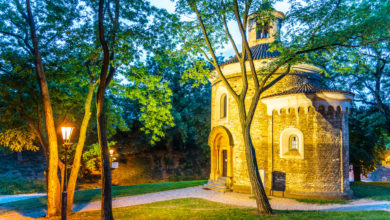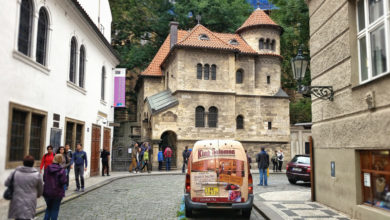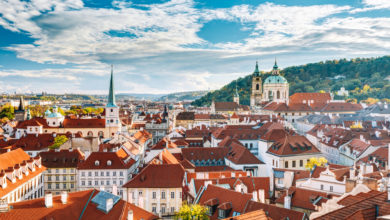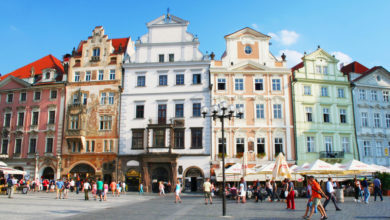Introductory Walk of Prague
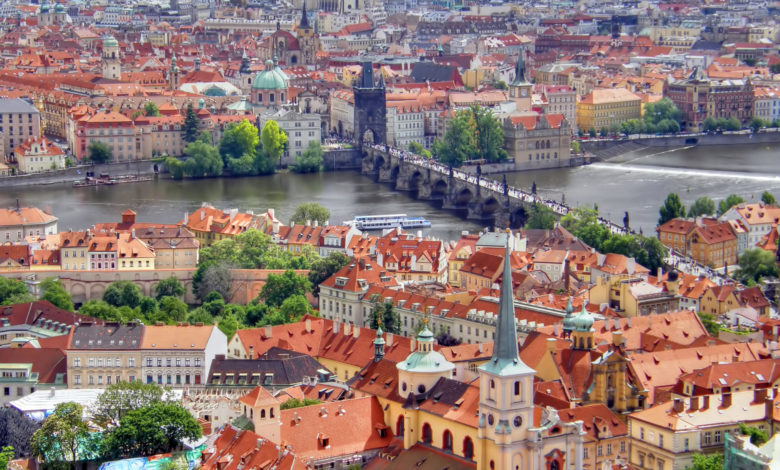
Because of its relatively small scale, many of Prague’s most important historical sites can be explored within a single walking tour. That’s exactly what this sets out to do. Depending on how much time you have, you can enjoy a 2-3 hour whistle-stop tour, or, if you have the whole day to spare, explore some sites in more detail. Remember, every step you take on this tour will be following in those of the Czech kings, who processed from the Powder Tower to Prague Castle on coronation day over a span of four centuries.
1. For all its astoundingly preserved history, we will begin in the modern centre of Prague. One of the first things you’ll notice about Wenceslas Square is that it isn’t much of a square at all; it is more like a long boulevard. In fact, the square only earned its current name in 1848. Before that, it was called Horse Market, and this accounts for its shape and size; imagine the mass of horses and traders which once gathered here.
2. Undergoing extensive renovations at the moment, Prague’s National Museum stands proud at the top of Wenceslas Square and has witnessed some of the city’s most vital moments. At the foot of the museum, steps are a memorial to Jan Palach – the student infamously set himself alight in protest at the Soviet-led invasion of the Czech Republic in 1968. Do not be fooled by the Square’s garish, sometimes seedy façade. Instead, cast your gaze upwards for some wonderful examples of Art Nouveau architecture, including the exquisite Grand Hotel Europa.
3. At the bottom of Wenceslas Square, turn right onto the busy shopping street of Na Příkopě (which means ‘on the moat’). Here stretches an array of high street brands and the Museum of Communism, wedged with no sense of irony between a casino and a McDonald’s. Keep a keen eye out to the right, too; Panská is home to the Mucha Museum, while two delightfully Venetian-style bridges span the parallel Nekázanka.
4. As you reach the end of Na Příkopě, the architecture becomes fascinatingly juxtaposed. To your right is the imposing Czech National Bank, which you may recognise from a scene in the action movie xXx when Vin Diesel perches its statue. To your left is an even more striking building – the Gothic Powder Tower, which was once a part of the city’s mediaeval defences and earned its name when converted into a gunpowder store during the 17th century.
5. Just as striking as the Powder Tower is the building it is adjoined to – the majestic Municipal House (Obecní dům), which was built during the country’s halcyon days between 1905 and 1912. On its balcony, the first Czechoslovakian state was declared.
6. Once you have taken in these incredibly juxtaposed sites of Náměstí Republiky, enter under the Powder Tower and onto Celetná. Though today Celetná is somewhat choked with tourist outlets flogging knick-knacks of varying quality, keep your eyes peeled for the one-of-a-kind House of the Black Madonna – a Cubist structure designed by Josef Gočár, and today contains a museum of Cubism and the glorious Grand Café Orient.
7. Greeting you at the end of Celetná is Prague’s Old Town Square. One of the Square’s standout features is the Church of Our Lady Before Týn, which, if you observe closely, has two similar yet different spires; great for a game of real-life spot the difference.
8. The Square’s centrepiece, however, is its Astronomical Clock. This impossibly intricate device dates from 1410, and it is said that the Clock’s inventor was blinded when his creation was completed so that he would never repeat his masterpiece in any other city.
9. Now with the Clock to your right, walk straight through Malé náměstí, and from here cross straight through Jilská, and onto Karlova, which is interrupted by Husova, and picks up again slightly off to the right. As you battle your way through the tourist mob, take a moment or two to visit one of the marionette shops; these wooden figures are famous in Prague, and there are several dedicated theatres in the area.
10. At the end of Karlova, you will be facing the Charles Bridge. Although this structure dates back to the 14th century, it is not the first bridge to have stood here; St. Judith Bridge collapsed in floods in 1342. Its replacement, which you are crossing now, was built by King Charles IV in 1357. The story goes that superstitious was the king; he consulted his astronomers on the ‘luckiest’ day to commence work on the bridge. They returned to him with the palindromic date of the 9th of July 1357 at 5:31. Think about it…
11. As you leave the bridge at the other end, admiring its other ancient tower as you do, walk straight up Mostecká until you reach Malostranské náměstí, which is dominated by the dome of St Nicholas Church (one of three bearing that name in Prague). Admire it from the outside – if you have time, go in to gawp at its lavish gilded interior – as you work your way around to the left, and then follow the hill that begins in the top right-hand corner of Malostranské náměstí.
12. This steep incline – Nerudova is its name – will lead you via a cluster of restaurants, bars and galleries, to the giddy heights of Prague Castle. As you make your way up, be sure to take plenty of breathers, using the excuse of stopping to appreciate the intricate stone carvings that adorn many buildings. Keep an eye out in particular for a couple of petrifying looking eagles.
13. As Nerudova forks off, veer onto the stone steps on the right. These will take you to Prague Castle. From its lofty position, you have one of the city’s best vantage points, and if the weather’s good, you can see the ‘Golden City’ stretch out for miles before you.
14. The Castle complex itself contains no shortage of things to do, including beautiful gardens, a toy museum and the Strahov monastery, with its famous library and brewery, which makes a delicious menu of seasonal ales. The soaring St Vitus’ Cathedral dominates Prague Castle, and seeing its rich stained glass windows is a must. Although there is a charge to visit the Cathedral in its entirety, visitors are still permitted to stand in the first third or so for free. It’s said that if you claim to want to pray there, the Cathedral staff have no option but to admit you into the rest of the building gratis.
15.If by now, your feet are too tired to continue, turn away from the Castle gates, leave the square, keeping the small triangular park to your right, and head onto Loretánská, which intersects after about four blocks with Keplerova. Here, you will see the Pohořelec tram stop. Otherwise, go into the Castle gates, through the first courtyard and into the second courtyard, where you will see an archway exit on your left. Then, over the bridge and past the Riding School Gallery to Mariánské Hradby, pass through the archway, where you will see the Pražsky hrad tram stop. Whichever stop you plump for, tram no. 22 will deliver you back into the centre of the city.

